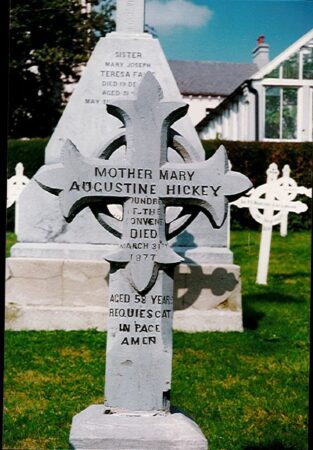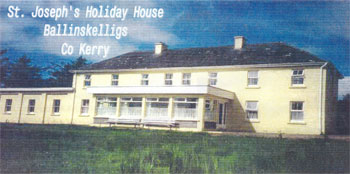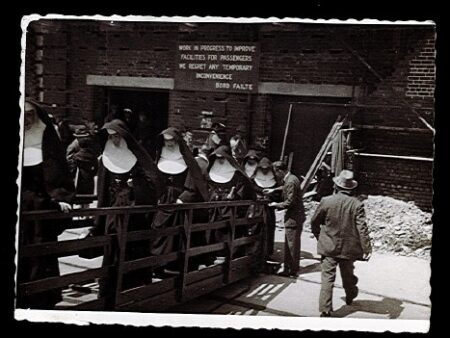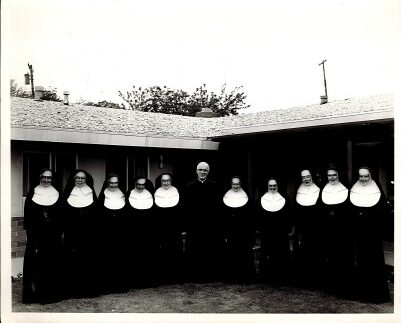The parish of Donoughmore, Co Limerick, has recently been looking back on its history. Last year the schools and the students who attended down the years were researched. This year they are exploring the religious and priests who have come from the parish. Mother Canice who entered in Doon, Co Limerick came from Donoughmore, and looking back on her life in order to help the parish with its research brought back many memories of a time gone by and a way of life that no longer exists. Perhaps there is a tendency to see the past through rose-coloured glasses but writing the short memoir which follows recalled images of an ordered, peaceful existence with regular prayer and work, and a garden full of beauty and colour, glorious in all the seasons, daffodils and hyacinths before roses, followed by a wonderful display of dahlias and gladioli. So many of the gifted women who only knew this way of life and yet achieved so much would surely revel in the freedom and opportunities which are now part of religious life. Mother Canice was one of these women.
Mother Canice McGrath, baptised Maud McGrath, was born to Patrick and Mary McGrath, Cahernorry, Co Limerick on 1st December, 1899. Her siblings in the family were Evelyn, Fr. Tom, an Oblate Priest in South Africa, Michael, Leo and Joseph. She entered the Convent of Mercy, Doon, Co Limerick on 28th August, 1918 and was Professed on 31st March, 1921. She died on 4th September, 1975.
 Grave of Mother Augustine Hickey, first Superior from Convent of Mercy, Kinsale, Co Cork
Grave of Mother Augustine Hickey, first Superior from Convent of Mercy, Kinsale, Co Cork
 Throughout her life in the Sisters of Mercy in Doon she served many years in leadership roles. She was chosen as Bursar in 1934 while still in her thirties. She was elected Superior of the convent in 1940 and remained in one or other role until 1973. She was a person of quiet sincerity and deep faith, with a strong sense of justice. Vatican II (1962 – 1965) brought many changes in the way religious life was lived. The orders were to adapt to the changing social conditions of the twentieth century so that the way of life, of prayer, of work, of governance of the Sisters would be in harmony with their physical and psychological well being. The Doon Sisters, under the guidance of Mother Canice, took the recommendations on the renewal of religious life to heart. This led to adaptation to a simpler life style, letting go of the religious habit, more involvement by all of the Sisters in decision making, new forms of prayer and Sisters living outside the confines of the community.
Throughout her life in the Sisters of Mercy in Doon she served many years in leadership roles. She was chosen as Bursar in 1934 while still in her thirties. She was elected Superior of the convent in 1940 and remained in one or other role until 1973. She was a person of quiet sincerity and deep faith, with a strong sense of justice. Vatican II (1962 – 1965) brought many changes in the way religious life was lived. The orders were to adapt to the changing social conditions of the twentieth century so that the way of life, of prayer, of work, of governance of the Sisters would be in harmony with their physical and psychological well being. The Doon Sisters, under the guidance of Mother Canice, took the recommendations on the renewal of religious life to heart. This led to adaptation to a simpler life style, letting go of the religious habit, more involvement by all of the Sisters in decision making, new forms of prayer and Sisters living outside the confines of the community.
 Doon Convent was founded from the Sisters of Mercy in Kinsale in 1865. When the first group came the people of Doon were poverty stricken and devastated as a result of the famine (1845 – 1849). Their plight was so bad the Sisters hardly knew how to help them but they began by visiting families who had sick members and they started a school in the garden of the convent. From the beginning there was friendship and rapport between the people and the Sisters. The way of religious life then was enclosed and monastic and remained so for the next hundred years. But Mother Canice, in her leadership role, was always to the forefront, both in seeing to the well-being of the Sisters and, above all, doing everything in her power to help the Sisters in their work. She believed that they should be as highly educated as possible. She gave much assistance in the building of the schools, encouraging new subjects in the secondary school, like art, German and music so that the student population would have many career opportunities. But she was never carried away by success. She stayed simple and humble looking to the human wants of many local people who may have needed a little help, and being interested in the families of the Sisters in their troubles and joys. When she died many stories were told of all the kindness and help she bestowed in secret.
Doon Convent was founded from the Sisters of Mercy in Kinsale in 1865. When the first group came the people of Doon were poverty stricken and devastated as a result of the famine (1845 – 1849). Their plight was so bad the Sisters hardly knew how to help them but they began by visiting families who had sick members and they started a school in the garden of the convent. From the beginning there was friendship and rapport between the people and the Sisters. The way of religious life then was enclosed and monastic and remained so for the next hundred years. But Mother Canice, in her leadership role, was always to the forefront, both in seeing to the well-being of the Sisters and, above all, doing everything in her power to help the Sisters in their work. She believed that they should be as highly educated as possible. She gave much assistance in the building of the schools, encouraging new subjects in the secondary school, like art, German and music so that the student population would have many career opportunities. But she was never carried away by success. She stayed simple and humble looking to the human wants of many local people who may have needed a little help, and being interested in the families of the Sisters in their troubles and joys. When she died many stories were told of all the kindness and help she bestowed in secret.
 In the 1950’s and 1960’s Mother Canice initiated several new ventures. She had tremendous interest in the mission work of the church, having guided many of the Doon pupils to missionary orders, so when St. Patrick’s Seminary, Thurles, in 1950, asked her for Sisters to help run the culinary department of the college and also to nurse those who were sick she saw it as a further opportunity to support the missions as the students in the college were bound for dioceses overseas. Four Sisters went to work there and the association of Doon with St. Patrick’s continued for many years. In 1961 the final part of Doon Secondary School was built, and also the custom of a yearly holiday by the sea for the Sisters was introduced when a house was purchased in Ballinskelligs, Co Kerry in 1962.
In the 1950’s and 1960’s Mother Canice initiated several new ventures. She had tremendous interest in the mission work of the church, having guided many of the Doon pupils to missionary orders, so when St. Patrick’s Seminary, Thurles, in 1950, asked her for Sisters to help run the culinary department of the college and also to nurse those who were sick she saw it as a further opportunity to support the missions as the students in the college were bound for dioceses overseas. Four Sisters went to work there and the association of Doon with St. Patrick’s continued for many years. In 1961 the final part of Doon Secondary School was built, and also the custom of a yearly holiday by the sea for the Sisters was introduced when a house was purchased in Ballinskelligs, Co Kerry in 1962.

St. Joseph’s Holiday House, Ballinskelligs
Another undertaking which was a first for Doon Convent took place in 1959. The Bishop of Sacramento in California looked for Sisters to run a Catholic school and arrangements were made for six of the Doon Sisters to settle in Fair Oaks, a town about twenty miles from Sacramento where a newly developed space industry caused a large expansion in the population. They made their first journey there by ship from Cobh and on that occasion Mother Canice went with them to settle them in and make sure that all was well for them.

Sisters boarding the ship to USA
They arrived in San Francisco after several weeks and spent their first week in the US in the Mercy Convent in Burlingame, the mother house of the San Francisco Mercy Sisters. There is an interesting link between Burlingame and Doon because both of those convents were founded from Kinsale. In 1854 Mother Baptist Russell at the age of twenty five led seven young women on a journey of 8,000 miles across the Atlantic, a journey which took three months. Now one hundred and five years later Sisters also founded from Kinsale were making a similar journey. The year 1972 saw the opening of another convent in California by the Doon Sisters, this time in Millbrae, near San Francisco, and once again, Mother Canice was there.

The Sisters who went to Fair Oaks in 1959
From left: Sr. Kieran O’Neill, Sr. Rosario Ryan, Sr. Angela O’Gorman, Sr. de Pazzi McKeogh, Mother Canice McGrath, Sr. Catherine Troy, Sr. Lelia O’Dea, Sr. Assumpta White. Also included is Fr. William Horgan, Pastor of St. Mel’s, Fair Oaks
One of Mother Canice’s most abiding legacies with continuous consequences started after Vatican II as the guidelines for the renewal of religious life asked that union of houses of the same order was to take place. Until then Mercy convents had been autonomous units each running its own affairs. In 1966 when Dr. Morris, Archbishop of Cashel and Emly returned from the Vatican Council he began the work of changing the Mercy Sisters’ rule which had been in existence since it was written by the founder of the order, Catherine McAuley, in 1831. The revision of the rule prompted the four main Mercy convents, Templemore, Tipperary, Doon and New Inn to get together, leading to meetings, mobility and openness to merging into one new entity. As a result diocesan amalgamation of all the Mercy Sisters in the diocese of Cashel and Emly took place on 5th January, 1973. The process continued until on 14th July, 1994, the twenty six diocesan groupings in Ireland came together as a new congregation.
Mother Canice was not here to see that but her openness, flexibility and desire for what was best was a key part in the success of the process. It is hard to sum up her life; perhaps the following simple words say it well: Our lives are never measured by how many years we live, but by the kindly things we do and the happiness we give.
Mary Coyle rsm
South Central Province


